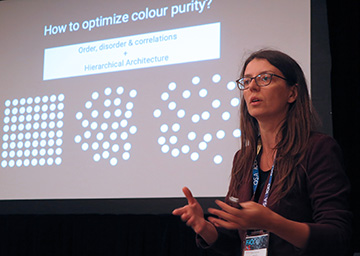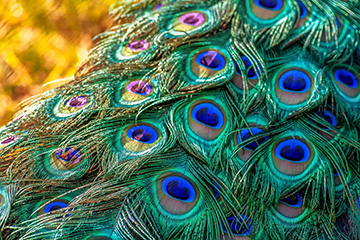
Silvia Vignolini at FiO+LS 019. [Image: Alesia Kirkland]
In a morning session on “Nonlinear Nano- and Biophotonics” at Frontiers in Optics+Laser Science 2019, Silvia Vignolini of Cambridge University, U.K., reviewed her work in the world of structural color—using arrays of light-scattering nanostructures to create colors without dyes or pigments.
This approach to constructing colors is well developed in the natural world—from the squid to the peacock to the blue Morpho butterfly. Vignolini and others have used these natural examples to develop toolkits for creating structural colors that could offer a more sustainable alternative to conventional pigments, the production of which can have baleful impacts on the environment.
In her talk, Vignolini looked at the basics of these engineered colors, and how parameters evolved in natural systems—such as hierarchies of nanostructures and the careful tuning of disorder—offer control knobs for achieving structural-color effects. Recently, to move toward an environmentally sustainable approach to color, she’s been exploring the use of bacteria as factories for nanophotonic building blocks, and of natural cellulose fibers as the basis for structural-color materials.
OPN chatted with Vignolini after her talk to get at some of the backstory of her work.
I’m curious about how you got interested in structural color and biomimetic engineering of this kind.
I did my Ph.D. in near-field optics, and studying 2-D photonic-crystal structure, mapping light propagation there. And so I was really focusing in that direction. Toward the end of my Ph.D. I became a bit de-motivated in this area … It felt like to do this kind of science, you needed to have the technological means and resources to enable the work.
It was my luck—because I’m really happy now, but I didn’t know about this at the time—that I applied to another group at Cambridge, and a project working on optical properties of plants was offered to me. The person who became my postdoc adviser was looking for someone able to do some optical characterization and modeling to describe the optical properties of these plants.
At the beginning I was so skeptical! The reason that I went there was that the group seemed very nice, and the amount of equipment in the lab—this was Jeremy Baumberg’s lab—was like paradise compared with what I had had before. So in spite of the fact that I wasn’t really convinced by the topic, I started there. And since then, I actually have gotten deeply interested.
It must have been kind of a culture shock, moving into such an interdisciplinary area.
Well, I think that the way that physics and optics are taught in the standard course is—it’s fine, but you don’t see actually much about how it can be useful for soft matter. Today, of course, there are some courses in biophysics. But in my time, it was kind of exotic, crossing disciplines.
But now, sometimes, in my research direction, I see the question not so much in terms of the optics. Instead, I see optics as a tool to answer research questions.
You showed a number of beautiful examples of natural systems that use these nanostructure to create color. Do you have any favorites—any that have really informed your own work over the years?
What made my luck, and my career, was a strange fruit that made its [structural] color using cellulose, in a helicoidal structure in the cell wall. And where I started my independent research career was in trying to understand how these fruits make these helicoidal structures.
Even today, this helicoidal architecture in nature is still one of the things that “keeps me awake at night”! Discovering how it’s possible to create this building block in nature; how it’s possible that these plants develop it … You start with a question, and you arrive at many others. The fruit that I started my career with is still posing more questions than answers!

[Image by analogicus from Pixabay]
In general I don’t like this idea of “biomimetics”; often it’s an oversold concept. But I really believe that if you learn how to make a structure with similar components, you start to appreciate the complexity in how the structure is initially made. And from making them artificially and using similar principles, and going back and studying the properties from a chemical and anatomical point of view—you really can learn quite a bit. And so in that sense, biomemetics can be really powerful in order to understand and to make materials.
Many of us think of structural color as these very iridescent things, like the peacock’s feather, where the color changes depending on the angle of view. But a lot of your work seems focused on finding structural colors that aren’t iridescent—where the color is the same in any direction.
Yes—because when you talk with a company that’s interested in pigment development, the question that they ask from the customer point of view is, does this color look like a “normal” color? The majority of colors that we have surrounding us are coming from pigments. So it’s our way of perceiving the world—the way that we’re trained. Unless you want “special effects.” But for pigments, it’s not usually acceptable to have jacket that changes color while you’re moving!
Actually, many species use structural colors that are angle-independent. The Morpho butterfly is the most famous example—if you look at it in real life, it looks blue independent of the angle. Why? Is it used by the insect to communicate? Or did nature just not optimize in this case?
We’ve tried to answer these questions. Generally, flowers, for example, tend to optimize for the pollinator. And we did a study that showed that for some flowers and pollinators, the pollination was faster if the structural colors were angle-independent.
So every photonic structure is optimized to please the “end user”; if you’re a flower, and you please your end user, there’s a higher chance that you get pollinated and survive. There is no one recipe—there is diversity, and that’s also the beauty of the natural world. This diversity and structure are optimized or evolved for a specific function. For humans, we are used to more conventional types of color, and as a customer you feel safer having something that is familiar.
![]()
Silvia Vignolini at FiO+LS 019. [Image: Alesia Kirkland]
How do you view the significance of this work? What can these structural colors give us that other kinds can’t, and what are the applications you’re targeting?
When you move to applications, my aim is to try to do something that is significant and useful. At the moment, the theme that’s nearest to my interest and heart is this global-warming emergency that we’re in. When you think about color and how color is made, there are ways to make things more sustainably. And I try to teach my students that you have to think about the impact of the material that you put into circulation.
Within this context, that’s why I want to work with natural polymers. In principle you can achieve exactly the same thing with plastics, but the challenge is to use materials that, to some extent, can be integrated into the environmental cycle, have a low impact on the environment, can be sustainably resourced.
Yes; it was great the way your talk moved from the experiments in plastic to the natural examples you’re using now—cellulose fibers, where your career kind of started, or even using bacteria as factories to generate natural materials with interesting optical properties.
What are the challenges in working with a natural material of this type—rather than a synthetic one, like a plastic? It seems, in a way, like working with the natural material would be more difficult.
The challenge depends on the system. Natural materials come from natural sources that have to go through some kind of treatment to be used. Often they are very resource-dependent—we call different things cellulose, but they can be completely different if extracted from one kind of tree versus another. That’s also why it’s important to work with material in this circular-economy sense—you optimize the material from a specific area that has specific characteristics applicable to the final end product.
And, from an environmental point of view, you want a resource that can be sustainably harvested. You don’t want to cut down every tree of the forest to get the natural materials that you want! The good thing is that you need to treat the cellulose in any event, and it’s been shown that you can extract it from mango peel waste, from banana waste, from many different wastes. The cellulose that we use in our experiments is a waste product of the cotton industry—the small fiber of cotton that they can’t interweave into yarns, because they’re too short.
